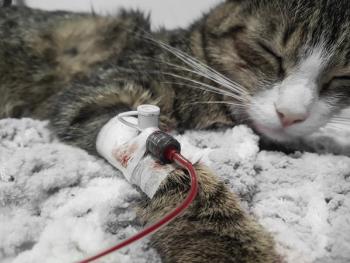
5 tips for discussing dermatology with veterinary clients
Communication is key to treatment success and reduced caregiver burden in dermatology cases. Use these tips to you communicate better with pet owners about these often confounding conditions.
Chronic dermatology cases can be very disheartening for pet owners and can significantly impact the pet’s quality of life, said Ashley Bourgeois, DVM, DACVD, during a lecture last week at the
Results of a
“We can essentially establish a normal quality of life for our dermatology patients and clients by managing that disease,” said Bourgeois, who owns Animal Dermatology Clinic in Portland, Oregon. “We can make these owners feel confident and bring back the joy in having their pet.”
To maximize treatment success and reduce caregiver burden, good client communication is key, said Bourgeois. Here are her top 5 tips for communicating with your dermatology clients.
1. Plant the seed early
Start the discussion about allergies at the first infection, Bourgeois advised. Infections are secondary issues related to allergies, she said, which makes discussing them early on so important.
Think you have the time to talk with clients about allergies? You don’t have to give a 30-minute lecture, said Bourgeois. Keep it short and sweet. Address the client’s short- and long-term concerns. Reassure clients that their pet’s itchiness will be relieved immediately with an antipruritic but that there might be an underlying cause that needs to be determined—and getting to the root of the problem can take time. When clients understand upfront that skin issues are often lifelong and treatment is not always straightforward, future frustrations are fewer.
2. Be proactive about flare-ups
“Flare-ups happen, even in pets whose allergies are well controlled,” Bourgeois said. “It’s just the nature of the disease process.” Owners need to understand that and be proactive rather than reactive when flare-ups occur. Provide pamphlets, links to online videos, and other educational material so they know what to look for and what to do.
She also advised scheduling routine check-ins to find out how therapy is going and to address any client concerns. Provide different methods of contact such as phone, email, text messaging, and communication apps so they can contact you easily if they observe flare-ups.
Also, get your entire team involved,Bourgeois said. “Our staff is trained to say things like, ‘Allergies can fluctuate based on the season. If you notice any paw licking in the summer, let us know.’”
3. Be empathetic
Bourgeois stressed that empathy is crucial when it comes to your dermatology clients. They might be fed up, burnt out, and even teary-eyed when discussing their pet’s chronic condition. “When we can relate to them and recognize their goals, we have the best opportunity to make progress with a treatment plan and become a part of that pet’s team,” she said.
Also, validate your client’s feelings. Reassure them that you understand their frustrations, and always ask them if they have any questions for you. Make sure your treatment plan is realistic for them and let them know it’s OK to let you know if it’s not.
4. Make connections
Sometimes, using human concepts can make it easier for clients to grasp what their pet is experiencing and how to best manage the pet’s allergies. “People tend to understand things better if they know a human who has gone through something similar,” said Bourgeois. For example, liken flea allergy dermatitis in pets to bee sting allergy in people, food allergies or ectoparasite hypersensitivity in pets to peanut allergy in people, or seasonal allergies in children to ear infection in dogs.
5. Try referrals
Do you have a strong relationship with your local dermatologist? If not, develop one. “Many cases need to be co-managed,” Bourgeois said. Not sure when to refer your clients to a specialist? Here are a few strong indicators:
- A pet owner appears eager and proactive about allergy testing.
- Your client has come in several times for recurrent infections.
- A patient is not responding to therapy and requires a multimodal approach to treatment.
- You’re overwhelmed by your dermatology cases.
Many clients are willing to go for a referral if you explain the benefits, said Bourgeois. If there aren’t any veterinary dermatologists in your area, consider looking into telehealth options.
The take-home
The more you engage in these challenging conversations with your clients, you’ll find dermatology cases a lot more enjoyable, said Bourgeois. “Ultimately, we just want these pets to be more comfortable, and for these pets owners to be happier,” she concluded.
Newsletter
From exam room tips to practice management insights, get trusted veterinary news delivered straight to your inbox—subscribe to dvm360.




